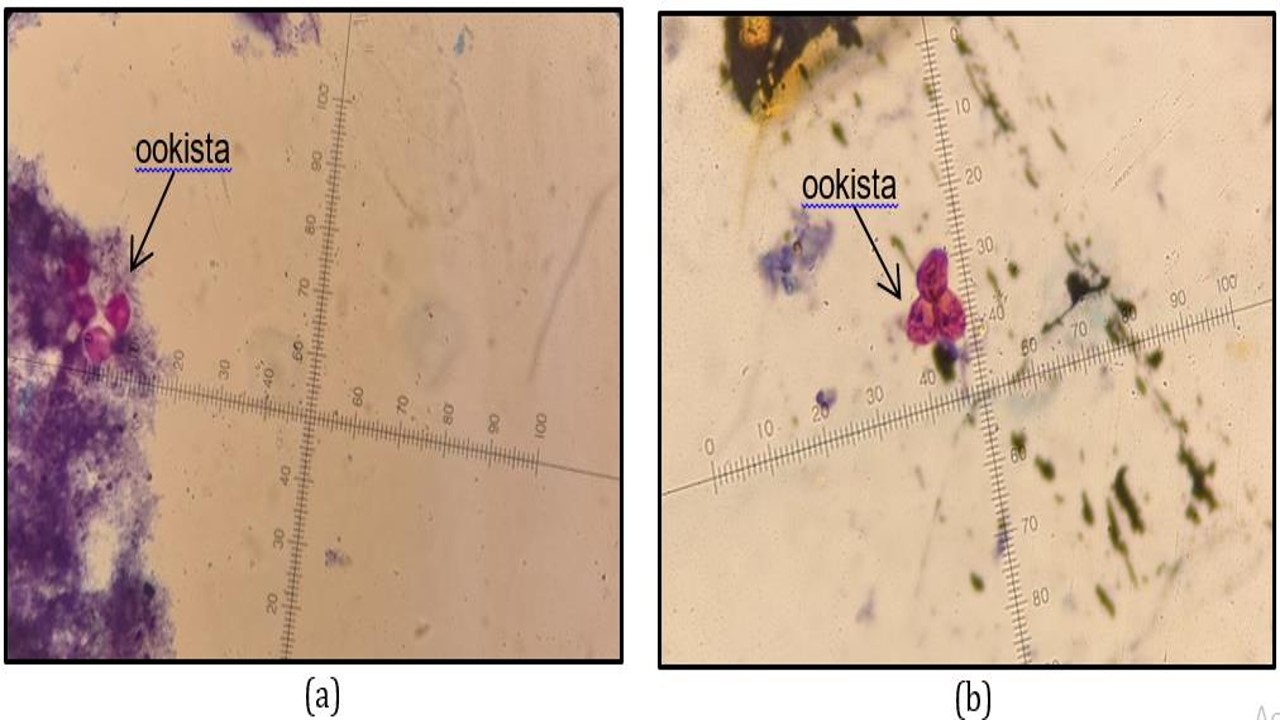Stall Sanitation Associated with Cryptosporidium sp. Infection on Calf and Cattle Farmer

Downloads
Increasing the cattle population can increase the amount of the waste. Poor management of cage sanitation has the risk of causing a decrease in the health conditions of cattle farmers, such as: diarrhea, nausea, vomiting, and itching, as many as 50% of cattle with diarrhea are infected with Cryptosporidium sp. The highest infection of Cryptosporidium sp. in cattle found in calves. The calf can excrete 1í—1010 oocysts of Cryptosporidium sp. per day. Cryptosporidium sp. also has the potential to cause zoonotic infections that are transmitted from animals to humans. The study aims was to determine the relationship between stall sanitation and Cryptosporidium sp. to calf and cattle farmer. The type of this research was analytic observational with a cross sectional approach conducted in Jatian Village, Pakusari, Jember during October 2021 - March 2022. The primary data was obtained through interviews and observations. The feces of calves and cattle farmer were collected and examined using sedimentation method and modified Ziehl-Neelsen (MZN) staining method. The statistical test used is the chi-square test. The results showed that the prevalence of Cryptosporidium sp. in calves by 14,3% and on cattle farmer by 4,8%. The bivariate analysis showed that that stall location and waste handling were associated with Cryptosporidium for calf (p≤0.05), and there were no variables that were significantly related to infection in cattle farmers (p>0,05). Cryptosporidium sp. in calves and humans can be caused by several factors, such as environmental factors and hosts. Preventive measures such as maintaining a clean environment including cowshed sanitation and personal hygiene need to be taken to reduce the risk of Cryptosporidium infection from calves to humans, and vice versa.
Adliyani, Z. O. N., Angraini, D. I., & Soleha, T. U. (2017). Pengaruh pengetahuan, pendidikan dan ekonomi terhadap perilaku hidup bersih dan sehat pada masyarakat desa pekonmon Kecamatan Ngambur, Kabupaten Pesisir Barat. Majority Journal, 7(1), 6–13.
Alum, A., Absar, I. M., Asaad, H., Rubino, J. R., & Ijaz, M. K. (2014). Impact of environmental conditions on the survival of Cryptosporidium and Giardia on environmental surfaces. Interdisciplinary perspectives on infectious diseases, 2014(4), 210385.
Armon, R., Gold, D., Zuckerman, U., & Kurzbaum, E. (2016). Environmental aspects of Cryptosporidium. Journal Veterinary Medical Research, 3(2).
Badan Pusat Statistik (BPS) Kabupaten Jember. (2019). Populasi Ternak Menurut Kecamatan dan Jenis Ternak (ekor). Dinas Peternakan, Perikanan dan Kelautan Kabupaten Jember.
Bogan, J. E. (2018). Disinfection techniques for Cryptosporidium. Journal of Dairy & Veterinary Sciences, 7(4), 1–3.
Chalmers, R. M. (2014). Cryptosporidium; Encyclopedia of Food Microbiology: Second Edition). Elsevier. pp: 533–545.
Costa, D., Razakandrainibe, R., & Valot, M. (2020). Epidemiology of cryptosporidiosis in France from 2017 to 2019. Microorganisms, 8(9), 1–17.
Ernawati, D., & Gunawan, A. T. (2017). Faktor-faktor yang berhubungan dengan kondisi suhu dan kelembaban ruang keluarga di Dusun Kotayasa, Desa Kotayasa, Kecamatan Sumbang, Kabupaten Banyumas tahun 2016. Buletin Keslingmas, 36(4), 437-445.
Fawaid, B. (2020). Cage sanitation, hygiene of dairy farmer, physical quality and microorganism of dairy cattle milk in Medowo, Kediri, East java. Jurnal Kesehatan Lingkungan, 12(1), 69.
Gunathilaka, N., Niroshana, D., Amarasinghe, D., & Udayanga, L. (2018). Prevalence of gastrointestinal parasitic infections and assessment of deworming program among cattle and buffaloes in Gampaha District, Sri Lanka. BioMed Research International, 2018(1), 1-10.
Innes, E. A., Chalmers, R. M., Wells, B., & Pawlowic, M. C. (2020). A one health approach to tackle cryptosporidiosis. Trends in Parasitology, 36(3), 290-303.
Izadi, M., Jonaidi-Jafari, N., Saburi, A., Eyni, H., Rezaiemanesh, M. R., & Ranjbar, R. (2014). Cryptosporidiosis in iranian farm workers and their household members: a hypothesis about possible zoonotic transmission. Journal of Tropical Medicine, 2014(2), 405875.
Muhamad, N., Awaludin, A., & Nugraheni, Y. R. (2021). Koksidiosis pada sapi perah di Kabupaten Jember, Jawa Timur – Indonesia. Jurnal Ilmu Peternakan Terapan, 4(2), 60-65.
Nakibirango, J., Mugenyi, V., & Nsaba, D. (2019). Prevalence of cryptosporidiosis and hygiene practices among HIV/AIDS patients in Southwest Uganda. HIV/AIDS - Research and Palliative Care, 11, 141-145.
Nugraha, A. (2017). Kajian Prevalensi dan Faktor Risiko Kriptosporidiosis pada Peternakan Sapi Perah di Kabupaten Bogor. Tesis. Institut Pertaian Bogor. Hal: 6
Nugraha, A. B., Cahyaningsih, U., & Sudarnika, E. (2021). Prevalensi dan faktor risiko Cryptosporidium sp. pada peternakan sapi perah di Kabupaten Bogor. Jurnal Sain Veteriner, 39(1), 13–19.
Nurmasari, D. (2019). Hubungan Sanitasi Kandang Ternak Sapi dengan Kepadatan Lalat di Desa Jono Kecamatan Temayang Kabupaten Bojonegoro. Skripsi. Program Studi Kesehatan Masyarakat STIKES Bhakti Husada Mulia Madiun. Hal: 23.
Ogendo, A., Obonyo, M., & Wasswa, P. (2017). Cryptosporidium infection in calves and the environment in Asembo, Western Kenya: 2015. The Pan African Medical Journal, 28(Supp 1), 9.
Permatasari, R. I. (2018). Higiene, sanitasi dan kualitas bakteriologis susu sapi di dusun krajan, desa gendro, kecamatan tutur, kabupaten pasuruan. Jurnal Kesehatan Lingkungan, 10(4), 343–350.
Petersen, H. H., Dalsgaard, A., & Vinneras, L. S. (2021). Inactivation of Cryptosporidium Parvum Oocysts and Faecal Indicator Bacteria in Cattle Slurry by Addition of Ammonia. Journal of Applied Microbiology, 130(5).
Pumipuntu, N., & Piratae, S. (2018). Cryptosporidiosis: a zoonotic disease concern. Veterinary World, 11(5), 681-686.
Putra, F. A. I. A., Hidayat, N., & Afirianto, T. (2018). Penentuan kelayakan kandang sapi menggunakan analytic hierarcy process-weighted (ahp-wp) [studi kasus upt pembibitan ternak dan hijauan makanan ternak Singosari]. Jurnal Pengembangan Teknologi Informasi Dan Ilmu Komputer, 2(10), 4213-4220.
Sari, Y., & Situmorang, N. (2020). Pengaruh jarak kandang ternak terhadap total coliform pada air sumur gali di Desa Klambir. BIOLINK (Jurnal Biologi Lingkungan Industri Kesehatan), 6(2), 186–195.
Smith, R. P., Clifton-Hadley, F. A., Cheney, T., & Giles, M. (2014). Prevalence and molecular typing of Cryptosporidium in dairy cattle in England and Wales and examination of potential on-farm transmission routes. Veterinary Parasitology, 204(3–4), 111–119.
Utaaker, K. S., Skjerve, E., & Robertson, L. J. (2017). Keeping it cool: Survival of Giardia cysts and Cryptosporidium oocysts on lettuce leaves. International Journal of Food Microbiology, 255, 51-57.
Wijayanti, T. (2018). Kriptosporidiosis di Indonesia. Balaba: Jurnal Litbang Pengendalian Penyakit Bersumber Binatang Banjarnegara, 73–82.
Zakiyah, Y. (2018). Faktor lingkungan yang berhubungan dengan kejadian diare pada balita di Puskesmas Batang – Bantang Kabupaten Sumenep. Jurnal Ilmu Kesehatan, 1(2018), 10–17.
Zuroida, R. (2018). Cages Sanitation and Health Complaints among Dairy Farmers in Murukan Village, Jombang. Jurnal Kesehatan Lingkungan, 10(4), 434.
Copyright (c) 2022 Rafindra Ramadhani, Yudha Nurdian, Dwita Aryadina Rachmawati, Wiwien Sugih Utami, Yunita Armiyanti, Bagus Hermansyah, Angga Mardro Rahardjo

This work is licensed under a Creative Commons Attribution-NonCommercial-ShareAlike 4.0 International License.
Authors who publish in this journal agree to the following terms:
1. The journal allows the author to hold the copyright of the article without restrictions;
2. The journal allows the author(s) to retain publishing rights without restrictions;
3. The legal formal aspect of journal publication accessibility refers to Creative Commons Attribution-NonCommercial-ShareAlike 4.0 International License (CC BY-NC-SA).






11.jpg)




















